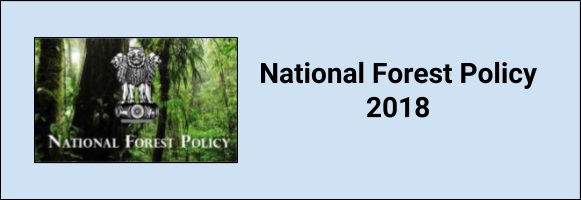NEW! The Gist (FREE) | E-BOOKS |
Draft National Forest Policy 2018 : Important Topics for UPSC Exams

Draft National Forest Policy 2018 : Important Topics for UPSC Exams
News:
Seeking to replace the country’s 30-year-old national forest policy, the Centre has come out with a new draft policy which calls for promoting urban greens, public private partnership models for afforestation, strengthening forest fire prevention measures and plantations in catchment areas to rejuvenate water bodies among many proposals to protect India’s green cover.
Background
Currently National forest policy of 1988 is being followed.
The new policy is in line with the present realities of climate change , wildlife and forest management.
It seeks to raise the country’s forest cover from 25% to 30%.
Additional Info
Forest survey of India - Organisation for conducting forest surveys, studies and research to periodically monitor the changing situation of land and forest resources and present the data for national planning, conservation and sustainable management of environmental protection as well for the implementation of social forestry projects.
It works under Government of India Ministry of Environment, Forest and Climate Change.
It is headquartered in Dehradun.
It publishes biennial "The State of Forest Reports". According to 2017 report, In terms of area, Madhya Pradesh has the largest forest cover followed by Arunachal Pradesh, Chhattisgarh, Orissa and Maharashtra.
Buy Printed Complete Study Materials for UPSC IAS PRELIMS Exam
Online Crash Course for UPSC PRE Exam
Objectives and provisions of the policy
-
To safeguard the ecological and livelihood security of people, of the present and future generations.
-
sustainable management of the forests for the flow of ecosystem services
-
To address the issue of climate change, NFP, 2018 contributes to the forestry-related Nationally Determined Contribution Targets and by integrating, “climate change mitigation and adaptation measures in forest management through the mechanism of REDD+ (Reducing Emissions from Deforestation and Forest Degradation plus) so that the impacts of the climate change is minimised”.
-
The draft policy document also talks about degraded land and how it can be improved by undertaking afforestation activities using public private partnership models
-
The lands available with the forest corporations which are degraded and underutilised will be managed to produce quality timber with scientific interventions. Public private participation models will be developed for undertaking afforestation and reforestation activities in degraded forest areas and forest areas available with Forest Development Corporations and outside forests
-
The document proposes creation of a community forest management mission for the community resource management under Forests Rights Act.
-
To manage problem animals, establish rescue centres and develop a team of well-equipped and trained personnel.
-
Voluntary and attractive relocation packages of villages from within national parks, other wildlife rich areas and corridors should be developed. Such areas should be effectively secured by strengthening enforcement, restoring habitats and establishing ecological corridors.
-
It also suggests setting up of two national-level bodies—National Community Forest Management (CFM) Mission and National Board of Forestry (NBF)—for better management of the country’s forests.

Concerns with the policy
-
Draft forest policy recognises the challenge of climate change but persists with the outdated approach on plantations. Productivity of forest plantations are poor in most states. This will be addressed by the intensive scientific management of forest plantations of commercially important species. It stresses the need for plantations of exotics like eucalyptus and casuarina. There is now compelling evidence that plantations are no substitute for biodiverse ecosystems comprising indigenous species when it comes to climate change mitigation.
-
The draft NFP 2018 mentions major forestry issues ailing the forest sector, but it doesn’t provide answers to them as to how these objectives will be achieved considering the competitive demands for forestlands. It’s worth noting here that most of the objectives mentioned in earlier 1988 policy have not been met so far.
-
it remains vague on the issue of forests rights for forest dwelling communities- FRA is a major movement in forest areas at present and its progress has been very lackadaisical over a decade of its implementation in India.
-
The draft policy fails to mention or address the degradation of growing stock in the natural forests.
Conclusion
-
The forest policy is forward looking in the sense that it takes into account the Supreme Court order in 2014 asking the environment ministry to set up an independent environment regulator for ensuring that environmental laws, including those with respect to forests, are enforced. The draft provides for setting up of a National and State Boards of Forestry for periodic review.
-
It will help India in fulfilling the targets under INDC’s .
-
The policy is forward looking in the sense that it integrates the contemporary issues of human wildlife conflict, climate change and others to make it more holistic.
-
The draft should only be finalized after discussing it with the wide range of stakeholders.
MCQ’s
1. Arrange the following states/UT’s in order of descending forest cover as a percent of geographical area as per the FSI report
-
Lakshadweep
-
Mizoram
-
Arunachal Pradesh
-
Kerala
Choose the correct option
-
A>B>C>D
-
C>B>A>D
-
D>C>B>A
-
C>A>D>B
Correct Answer: a

